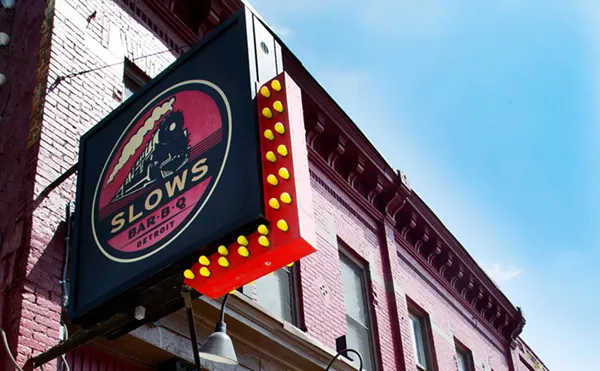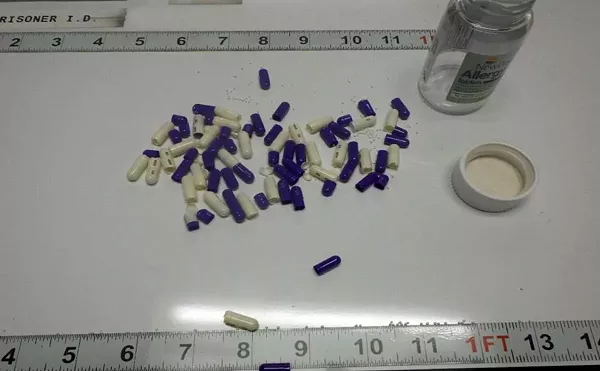How does an artist who left town 24 years ago get a one-person exhibition in one of the newer hip art galleries in town? It's quite a tale, especially if you like detective stories.
It begins late last year, in the back storeroom of Xavier's 20th Century Furniture, a high-end design and furnishings store on Michigan Avenue. That's where Rebecca Mazzei, the curator of Trinosophes, a performance space and art gallery on Gratiot Avenue near Eastern Market, was digging around in owner Xavier Slade's art and design library with co-curator Megan Stockton, looking for ideas for the space's Material for Living show.
Mazzei tells us, "I've always adored what Xavier has in there. He has a background in art, and so I've often gone in and gotten stuff and visited. He just has a great eye."
Mazzei then made a startling discovery.
"I saw this huge stack of posters, like, broadsides, and these glassine envelopes with prints. I pulled one out and said, 'This is amazing.' I immediately saw the Willis Gallery stencil. The prints were of these really beautiful, kind of industrial settings in photographs. I was like, 'What is this? And who is Jim Crawford?' Because they were all signed and numbered."
Xavier told Mazzei that Crawford was a Cass Corridor artist, and that he bought his shop from Crawford, who had used the building as his studio.
"Jim Crawford is not a name you often hear associated with Cass Corridor," Mazzei says, "and yet he had this show at Willis. That intrigued me, because that space has such a legacy, you know? And so I asked Xavier, 'Can I show these?'"
Slade agreed, adding that he wasn't even sure what to price them at, as he'd held onto them forever.
The work aroused the interest of Sandra Schemske and Daniel Sperry of Wayne State University.
"Sandra runs the University Art Collection at Wayne State," Mazzei says. "And they have a significant Cass Corridor collection. They hold some of the greatest work from that movement. And they were immediately interested. And she knew who he was, because she said, 'We have a piece from his Pile Series. We have a piece or two because he was in Kick Out the Jams.'" Mazzei says that show, the DIA's 1980 retrospective of Cass Corridor artists, was "really influential."
While Schemske and Sperry wanted to purchase the work for the university, they cautioned that they couldn't take it in front of their committee unless they were certain that Xavier rightfully owned the works. It fell to Mazzei to figure out where Jim was, find out if he was still alive, and establish that, yes, he had abandoned the works. "They happened to have an old phone number for him with an Indianapolis area code, and I called it. And it was him."
Mazzei handled the unusual errand of calling a stranger out of the blue more than two decades after his departure with her usual grace. "I just kind of introduced myself," Mazzei says. "He was a little confused. I was like, 'Did you sell your building in Detroit to Xavier Slade?' And he said yes. And I said, 'Xavier's still there. I'm good friends with him. I have an art space in Detroit, and I happened upon a series of works that we think are yours that you perhaps left there. He remembered the series and he said, 'Yes I left them there.'
"Of course it became a little tricky to discuss, because now the institutions wanted them. The more we spoke, he was willing to sign off that he had left them there. We created a contract and he signed off on it.
"But the more I talked to him, there was something about him I really connected to. ... We started having these really deep conversations. I could tell this was somebody I wanted to work with."
We speak with Crawford by phone on a late summer weekend, the same day the Dally in the Alley is taking place in his old stomping grounds. He audibly brightens up when discussing Mazzei's first call. "It was a surprise," he says, adding, "It was a delight. And we've just gone from there. And I think we have a really good working relationship."
That relationship culminates next month in a show featuring several different bodies of work by the artist who was perhaps the most striking outlier of the gritty Cass Corridor artists of the 1960s and 1970s. It's not often you see a one-person show with such a variety of work, from a period spanning decades.
Crawford agrees. He tells us, "People don't do exhibitions like this. They might do it in a retrospective in a museum, but they don't normally do it in a gallery. Rebecca is the only one that thinks these things through enough to put the integrity back historically and she's put this together in a really wonderful way."
'Heightened seeing'
Today, when we talk about Cass Corridor artists, we mostly think of the rugged assemblages of found objects. Detroit artist and educator John Egner said much of the art "evoked and echoed the real physical reality of Cass Corridor lofts, alleys, and apartments: woodwork that had been painted a hundred times; cracked or broken glass."
While not all the work traded in such ramshackle excesses, at the very least, Crawford's work tended to be more conceptual.
The difference went deeper than the art. Crawford was born just a bit earlier than the rest of the Corridor baby boomers, in rural Hillsdale, where his mom stayed with her mother during the war. He grew up on Grand River Avenue, and after the war lived just inside the city near Redford.
Also, trauma struck him relatively young, providing the impetus for his art.
"This artistic thing was a healing effort that came primarily from the fact that my mother had committed suicide," Crawford says. "The way I healed myself was through a long process of creativity. I've had a really strange adventure after sort of jumping outside myself."
Crawford's grandmother stepped in to care for him as a boy, and introduced him to what he calls "heightened seeing."
"When I was a child, my grandmother used to sit at the kitchen table and interpret tea leaves for people that would come over to the house," he recalls. "It was kind of magical for me as a child, and it just opened up a kind of wonder in the world."
Or as Mazzei says, "He describes that experience as a child as the first time he was interpreting meaning from what he was looking at, which is what you do with art."
As a student at Cooley High School, Crawford's ability was nurtured and rewarded. "I had all these scholastic art awards, and I got scholarships," he says. "I was really rewarded as a young person as an artist."
As a result, by the time Crawford moved into a rooming house on Forest in the late 1960s, he was in a different place than many Detroit artists.
"By the time I was in college, I was well aware that that's who I was: an artist. And it was an unusual situation, because a lot of the people I was around had decided to become artists in college." He adds with a laugh, "I had decided to become an artist when I was, like, 5."
Another difference was that Crawford had a stable day job. In 1970, he took a position as visual arts coordinator for the Michigan Council for the Arts, and began a long career as an arts administrator. The gig meant a steady income, and gave Crawford the opportunity to support individual artists, and pursue his own work somewhat more leisurely.
From that time, his work hinged on looking at things in new ways, which is one of the things he explored in the 1972 Piles Series Mazzei discovered more than 40 years later. Mazzei says, "In the original press release from Willis Gallery, he called them 'found forms.' So basically he was going around the industrial landscape and seeing stacks of concrete, stacks of pipes, stacks of tires, and basically experiencing them as if they were sculptures."
"That may sound like it's something we do all the time now: Scott Hocking and other people like that use found materials to create piles and stacks of things," Mazzei points out. "But at the time, that was not happening in the art world at large."
"Once you get turned onto it, you can't stop seeing this stuff all around you," Crawford explains. "It's just the way that things are casually stacked. Usually building materials, but you'll also find it in the department store. My stuff was different from the eclectic assemblages made from things other people didn't want, materials you could pick up in the alley because they were free. I see their work as very visceral. And I see my work at the other end of the spectrum more conceptual, an entirely different approach."
Putting it another way, Crawford has said: "Portions may have been added or subtracted, but it is not contrived sculpture."
As for photographing the materials on construction sites, Crawford says, "I thought there was more sculptural integrity in them. They seemed free-flowing, casual. ... The way that those materials are put together, delivered, just set down on the ground, from my point of view, it had the highest level of integrity and the smoothest process in which it all happened."
Of course, Crawford is frank that he could afford to be an outlier. He credits his unusual place in the Cass Corridor art scene to the fact that he had a day job.
"I had an income," he says. "So I didn't have to make a life in the marketplace. Consequently, I was able to remain pretty pure. I showed in all of those venues, but there was no great pressure to sell work."
For instance, one series of his work was created at his desk: Crawford would make his morning tea and take the teabags and set them on 3-by-5 cards and stain them. He created a set of more than 300 tea-stained cards, each of them with the sort of smooth, carefree, nearly unconscious process guiding them. When you consider how it meshes with his respect for ritual (and the way his grandmother read tea leaves), the meaning goes even deeper.
"They keep calling me a conceptualist," he says. "And concepts and ideas are very important in my work, but I don't necessarily want them to get in the way."
Crawford's efforts to confront the public and ask it to engage in a bit of "heightened seeing" was behind an impermanent artwork he did in downtown Detroit in the 1975. He used 50,000 pounds of ice to create four 8-foot-tall ice walls on the walkways of the Kern Block.
"These were gigantic walls of ice that were a story tall that obstructed the traffic," Crawford explains, "and people had to walk around them. You would never have been able to do something like that today." Asked if perhaps it was futile to try to get harried, get-the-job-done Detroiters to try to take a liking to challenging conceptual art, he replies with much laughter, "Somebody came with a truck and just knocked them down. ... They were not receptive to it. They obliterated it!"
But art in Detroit at the time was all about pushing boundaries, whether it meant dragging a large granite stone across the DIA's lawn or putting up walls of ice to surprise office workers. And that sort of weird work wouldn't have happened without the challenging art community in town, which reached from the rooming houses of the Corridor up to the offices of the museum and the university art departments, and beyond to Lansing, where state arts funding was relatively lavish.
Crawford credits such educators as Aris Koutroulis, who taught painting at what's now the College for Creative Studies, and John Egner, who taught at Wayne State. "They were the mother hens of a lot of the stuff that was happening," Crawford says. Add in all the working artists, a few edgy galleries, and you have a core that can make things happen.
"See what you have there is a community," Crawford says. "That doesn't happen very often. And that's why Detroit is so significant. That it did have a community that was vital enough to have a presence on a national scene. And it was because of a lot of different people, such as [DIA contemporary art curator] Sam Wagstaff, who gave it credibility. But it happened. There were enough people, and the community was tight enough."
Over time, however, that scene began to disperse. Many of the risk-taking administrators and academics moved on to New York. The Cass Corridor scene was already a proper subject for a backward-looking restrospective by 1980. And by the early 1990s, when Crawford was working out of his Michigan Avenue space, the crack cocaine epidemic was reaching its peak in Detroit. Crawford's day-to-day life was miles apart from the commune-like interracial community that sought out the Cass Corridor in the late 1960s. Crawford was hit by a string of burglaries in which even his bronze artworks were stolen, to be melted down for scrap, he guesses. At the time, even the manholes in the avenue would disappear.
To make matters worse, Michigan's new right-wing governor was slashing arts funding. Crawford says, "The Michigan Council for the Arts was being completely annihilated by Gov. Engler at the time. We went from 50 employees to 10. I quit the Michigan council for arts the very day I could get my retirement. I retired after 22 years."
Crawford sold the studio to Xavier Slade and left town, he says, due to "a very willful woman as much as anything else."
Rituals old and new
Indianapolis has been good to Crawford. He's an avid gardener who has spent 18 years in the same spot by the Indiana State Fairgrounds. Arts curator Mazzei traveled there to meet with him, and says, "He has an incredible studio and living space, and a beautiful garden around it. It's almost a compound."
It also seems that getting away from Detroit hasn't made him less productive as an artist. He's says he's been working on the same body of work for 15 years, since his last show in metro Detroit, but that he's had a "rush of creativity" that involves two newer series he's done over the last two years.
One of them is called the Eggshell Series, and it's a series of eggshells placed into egg cartons with some staining. It recalls the teabag series that came out of him starting his days at the MCFA, as well as referencing his grandmother's readings.
"When I would do my eggs in the morning over the frying pan," Crawford says, "I would open them up and then I'd put them back in the container. Eventually I stained them all with walnut stain from a walnut tree. There's probably about 40 of these pieces."
He says the artworks involve several factors: The point where vision becomes a meditation, the recording of gesture, a conscious sort of ritual. And that's not touching the eggs as symbols of rebirth, or the way ancient diviners saw the future in the entrails of slaughtered sacrificial animals. There's much for those into "heightened seeing" to witness there.
Crawford's other newer work is the Cat Can Series, consisting of artworks in which used cans of cat food are placed inside painted boxes. The fortune-teller's grandson says the project began with a vision of the future he had: "I had a dream," he says, "I saw this woman with long black hair facing away from me. And immediately, I thought, 'I'm going to meet a woman with long black hair.'"
Soon afterward, he had a cat with black hair and emerald eyes come into his garden. "She got pregnant," Crawford says, "and became insatiably hungry. And I found an unlimited supply of cans of cat food."
Those works and more will be part of his upcoming exhibition, including older pieces juxtaposed with enough new pieces to flesh his career out. It will be Crawford's first show in Detroit since his last one in Ferndale, 15 years ago.
Mazzei is thrilled to be able to show the new work. "I think what attracts me to them is that there's something ritualistic and mystical about them," she says. "Because his process is one of doing something with such attention and focus, but then not just doing that one thing and leaving it, but doing it over and over again. And I think there's a kind of meditative state in that for him."
She adds that it's the sort of art that's more than at first meets the eye, possessing a formal compositional quality that forces people to "really think about what he's doing with objects."
If that sounds a little high-toned to connect with, Mazzei helps break it down further: "It's a ritual. It has meaning. I guess the reason I connect to it is that so much art these days is post-internet culture. People are just using the reference points of pop culture and visual culture, and it seems to be kind of avoidance of any kind of relationship to the human experience. I think it's an intentional avoidance. But I don't connect to that kind of work. I like the kind of work that makes me feel as if I'm connecting to some little point of humanity.
"He was on the very early end of stuff that early minimalists were thinking of. And he was in our back yard. My sense is had he been more willing to participate in that world of schmoozing with collectors, he could have made it big. But he's a little more serious than that."
True to form, Crawford seems completely content being his own person and making his deeply personal art. It is ritual and ideas that are at the center of his world more than any specific place and time. Perhaps that's why he's reluctant to embrace a "homecoming" narrative for this show. He says, "I don't want people to get distracted. There are no fancy stories about me. I want it to be about the art."
Jim Crawford opens 6-10 p.m. Friday, Oct. 21, with a talk from Crawford at 3 p.m. Saturday, Oct. 22, at Trinosophes, 1464 Gratiot Ave., Detroit; 313-737-6606; both events are free and open to the public; exhibition runs through Dec. 23.






